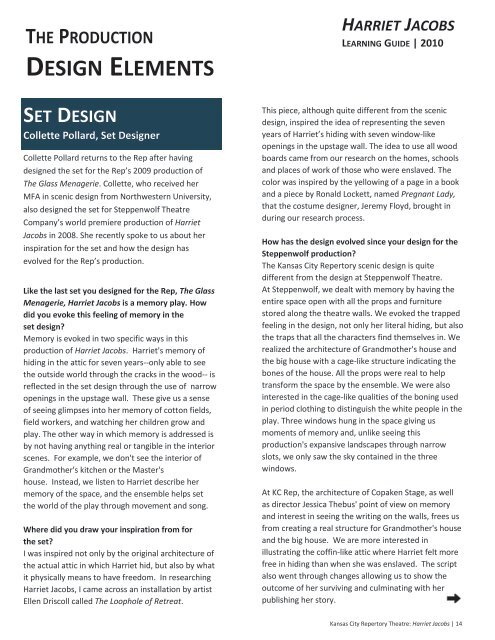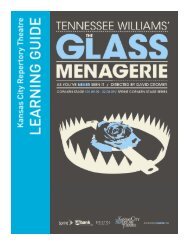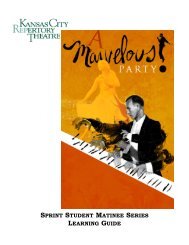Harriet Jacobs - The Kansas City Repertory Theatre
Harriet Jacobs - The Kansas City Repertory Theatre
Harriet Jacobs - The Kansas City Repertory Theatre
You also want an ePaper? Increase the reach of your titles
YUMPU automatically turns print PDFs into web optimized ePapers that Google loves.
THE PRODUCTION<br />
DESIGN ELEMENTS<br />
SET DESIGN<br />
Collette Pollard, Set Designer<br />
Collette Pollard returns to the Rep after having<br />
designed the set for the Rep’s 2009 production of<br />
<strong>The</strong> Glass Menagerie. Collette, who received her<br />
MFA in scenic design from Northwestern University,<br />
also designed the set for Steppenwolf <strong>The</strong>atre<br />
Company’s world premiere production of <strong>Harriet</strong><br />
<strong>Jacobs</strong> in 2008. She recently spoke to us about her<br />
inspiration for the set and how the design has<br />
evolved for the Rep’s production.<br />
Like the last set you designed for the Rep, <strong>The</strong> Glass<br />
Menagerie, <strong>Harriet</strong> <strong>Jacobs</strong> is a memory play. How<br />
did you evoke this feeling of memory in the<br />
set design?<br />
Memory is evoked in two specific ways in this<br />
production of <strong>Harriet</strong> <strong>Jacobs</strong>. <strong>Harriet</strong>'s memory of<br />
hiding in the attic for seven years--only able to see<br />
the outside world through the cracks in the wood-- is<br />
reflected in the set design through the use of narrow<br />
openings in the upstage wall. <strong>The</strong>se give us a sense<br />
of seeing glimpses into her memory of cotton fields,<br />
field workers, and watching her children grow and<br />
play. <strong>The</strong> other way in which memory is addressed is<br />
by not having anything real or tangible in the interior<br />
scenes. For example, we don't see the interior of<br />
Grandmother's kitchen or the Master's<br />
house. Instead, we listen to <strong>Harriet</strong> describe her<br />
memory of the space, and the ensemble helps set<br />
the world of the play through movement and song.<br />
Where did you draw your inspiration from for<br />
the set?<br />
I was inspired not only by the original architecture of<br />
the actual attic in which <strong>Harriet</strong> hid, but also by what<br />
it physically means to have freedom. In researching<br />
<strong>Harriet</strong> <strong>Jacobs</strong>, I came across an installation by artist<br />
Ellen Driscoll called <strong>The</strong> Loophole of Retreat.<br />
HARRIET JACOBS<br />
LEARNING GUIDE | 2010<br />
This piece, although quite different from the scenic<br />
design, inspired the idea of representing the seven<br />
years of <strong>Harriet</strong>’s hiding with seven window-like<br />
openings in the upstage wall. <strong>The</strong> idea to use all wood<br />
boards came from our research on the homes, schools<br />
and places of work of those who were enslaved. <strong>The</strong><br />
color was inspired by the yellowing of a page in a book<br />
and a piece by Ronald Lockett, named Pregnant Lady,<br />
that the costume designer, Jeremy Floyd, brought in<br />
during our research process.<br />
How has the design evolved since your design for the<br />
Steppenwolf production?<br />
<strong>The</strong> <strong>Kansas</strong> <strong>City</strong> <strong>Repertory</strong> scenic design is quite<br />
different from the design at Steppenwolf <strong>The</strong>atre.<br />
At Steppenwolf, we dealt with memory by having the<br />
entire space open with all the props and furniture<br />
stored along the theatre walls. We evoked the trapped<br />
feeling in the design, not only her literal hiding, but also<br />
the traps that all the characters find themselves in. We<br />
realized the architecture of Grandmother's house and<br />
the big house with a cage-like structure indicating the<br />
bones of the house. All the props were real to help<br />
transform the space by the ensemble. We were also<br />
interested in the cage-like qualities of the boning used<br />
in period clothing to distinguish the white people in the<br />
play. Three windows hung in the space giving us<br />
moments of memory and, unlike seeing this<br />
production's expansive landscapes through narrow<br />
slots, we only saw the sky contained in the three<br />
windows.<br />
At KC Rep, the architecture of Copaken Stage, as well<br />
as director Jessica <strong>The</strong>bus' point of view on memory<br />
and interest in seeing the writing on the walls, frees us<br />
from creating a real structure for Grandmother's house<br />
and the big house. We are more interested in<br />
illustrating the coffin-like attic where <strong>Harriet</strong> felt more<br />
free in hiding than when she was enslaved. <strong>The</strong> script<br />
also went through changes allowing us to show the<br />
outcome of her surviving and culminating with her<br />
publishing her story.<br />
<strong>Kansas</strong> <strong>City</strong> <strong>Repertory</strong> <strong>The</strong>atre: <strong>Harriet</strong> <strong>Jacobs</strong> | 14







